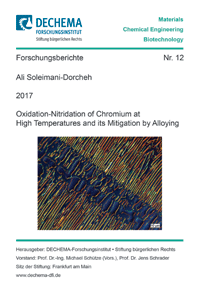
Shop : Details
Shop
Details
45,80 €ISBN 978-3-8440-5078-3Softcover132 pages58 figures186 g21 x 14,8 cmEnglishThesis
February 2017
Ali Soleimani-Dorcheh
Oxidation-Nitridation of Chromium at High Temperatures and its Mitigation by Alloying
This work investigates oxidation and nitridation in the binary Cr-Si system. Kinetics and thermodynamics of oxidation in this alloy system have been investigated with a systematic approach. Oxidation and nitridation behavior of each individual phase (solid-solution phase, Crss and silicide phase, A15) were studied separately by investigating the oxidation and nitridation kinetics for short and long term exposures, thermodynamic stability, and post-exposure characterization of the scale, and subscale morphologies. Results revealed that in both phases chromium is the predominant element in the oxidation process which made such alloys major chromia formers. It was found, however, that the role of localized SiO₂ formation in reducing oxidation kinetics is significant. The oxidation rate of chromium was reduced by more than an order of magnitude upon the addition of only 3 at.% Si. The impact of SiO₂ increased further with increasing Si content. The A15 Cr₃Si silicide phase produced a continuous SiO₂ layer at long term exposures. When combined in a two-phase eutectic alloy, both solid-solution and A15 silicide phases oxidized cooperatively via primary depletion of chromium which led to the dissolution of the Crss phase and formation of an A15 layer at the alloy-scale interface. The influence of nitrogen as an important oxidant in air was investigated for pure chromium and the binary Cr-Si alloys and it was shown that a chromium subnitride layer exclusively grew via inward diffusion of nitrogen. The positive role of Si in hindering nitridation was significant. It was revealed that the A15 silicide is stable at any nitrogen pressure at high temperatures and showed almost no solubility for nitrogen. As a continuous barrier in the subsurface region of the two phase eutectic Cr-Cr₃Si alloy, it offered a self-protecting character against internal nitridation. Further development of this alloy system was conducted after exploring the ternary Cr-Ge-Si system in the high chromium range (Cr > 80 at.%). Si and Ge showed interchangeable solubility in both solid-solution Crss and A15 phases, and addition of Ge stabilized the A15 phase by supporting the peritectic reaction in the Cr-Cr₃Ge system. The microstructure of the eutectic alloy remained fine-lamellar when up to 2 at.% Ge was added. Using this approach, nitridation, as the most important challenge in the development of chromium alloys, was significantly improved as the alloy microstructure remained unaffected from internal nitridation for a period of 1000 hours oxidation at 1200°C in air. Finally, the optimized oxidation behavior of binary and ternary alloys was discussed with regards to the morphology and adhesion of the chromia scale.
Keywords: Chromium; Nitridation; Oxidation; High Temperature; Cr-Si; Cr-based alloys
Schriftenreihe des DECHEMA-Forschungsinstituts
Edited by DECHEMA-Forschungsinstitut, Frankfurt am Main
Volume 12
Available online documents for this title
You need Adobe Reader, to view these files. Here you will find a little help and information for downloading the PDF files.
Please note that the online documents cannot be printed or edited.
Please also see further information at: Help and Information.
Please also see further information at: Help and Information.
| Document |  | Document | ||
| Type |  | |||
| Costs |  | 34,35 € | ||
| Action |  | Purchase in obligation and download the file | ||
| Document |  | Table of contents | ||
| Type |  | |||
| Costs |  | free | ||
| Action |  | Download the file | ||
| Document |  | Abstract | ||
| Type |  | |||
| Costs |  | free | ||
| Action |  | Download the file | ||
User settings for registered online customers (online documents)
You can change your address details here and access documents you have already ordered.
User
Not logged in
Export of bibliographic data
Shaker Verlag GmbH
Am Langen Graben 15a
52353 Düren
Germany
Am Langen Graben 15a
52353 Düren
Germany
Mon. - Thurs. 8:00 a.m. to 4:00 p.m.
Fri. 8:00 a.m. to 3:00 p.m.
Fri. 8:00 a.m. to 3:00 p.m.
Contact us. We will be happy to help you.



